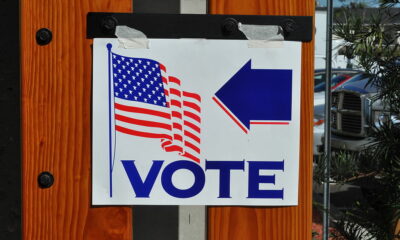Kaiser Health News
Out for Blood? For Routine Lab Work, the Hospital Billed Her $2,400

Rachana Pradhan
Tue, 21 Nov 2023 10:00:00 +0000
Reesha Ahmed was on cloud nine.
It was January and Ahmed was at an OB-GYN’s office near her home in Venus, Texas, for her first prenatal checkup. After an ultrasound, getting anti-nausea medication, and discussing her pregnancy care plan, she said, a nurse made a convenient suggestion: Head to the lab just down the hall for a standard panel of tests.
The lab was inside Texas Health Hospital Mansfield, which opened in December 2020 in a Dallas-Fort Worth suburb. Ahmed, just eight weeks pregnant, said the doctor told her everything about the visit was routine. “Nothing really stood out,” Ahmed said. “And, of course, there’s just a lot of excitement, and so I really didn’t think twice about anything.”
Her blood tests checked for multiple sexually transmitted infections, her blood type, and various hormones. Within days, Ahmed began bleeding and her excitement turned to fear. A repeat ultrasound in early February showed no fetus.
“My heart kind of fell apart at that moment because I knew exactly what that meant,” she said. She would have a miscarriage.
Then the bills came.
The Patient: Reesha Ahmed, 32, has an Anthem Blue Cross and Blue Shield policy through her employer.
Medical Services: An analysis of Pap smear results and several blood tests in tandem with Ahmed’s initial prenatal visit, including complete blood count, blood type, and testing for STIs such as hepatitis B, syphilis, and HIV.
Service Provider: Ahmed got her tests at Texas Health Mansfield, a tax-exempt hospital jointly operated by Texas Health Resources, a faith-based nonprofit health system, and AdventHealth, another religious nonprofit.
Total Bill: The hospital charged $9,520.02 for the blood tests and pathology services. The insurer negotiated that down to $6,700.50 and then paid $4,310.38, leaving Ahmed with a lab bill of $2,390.12.
What Gives: Ahmed’s situation reveals how hospital-based labs often charge high prices for tests. Even when providers are in network, a patient can be on the hook for thousands of dollars for common blood tests that are far cheaper in other settings. Research shows hospitals typically charge much more than physicians’ offices or independent commercial labs for the same tests.
The situation was particularly difficult for Ahmed because she had lost the pregnancy.
“To come to terms with it mentally, emotionally, physically — dealing with the ramifications of the miscarriage — and then having to muster up the fighting strength to then start calling your insurance, and the billing department, the provider’s office, trying to fight back a bill that you don’t feel like you were correctly sent? It’s just, it’s a lot,” she said.
In Texas, the same lab tests were at least six times as expensive in a hospital as in a doctor’s office, according to research from the Health Care Cost Institute, a nonprofit that examines health spending.
The markup can be even higher depending on the test. HCCI data, based on 2019 prices, shows the median price for a complete blood count in Texas was $6.34 at an independent lab and $58.22 at a hospital. Texas Health charged Ahmed $206.69 for that test alone.
“It is convenient to get your lab done right in the same building,” said Jessica Chang, a senior researcher at HCCI, but “many patients are not thinking about how highly marked up these lab tests are.” Chang said she suspects many hospitals tack on their overhead costs when they bill insurance.
Anthem also charged Ahmed for at least four tests that most insurance plans would consider preventive care and therefore covered at no cost to patients under the Affordable Care Act’s requirements for covering preventive care, which includes aspects of prenatal care. Her EOBs, or “explanation of benefits” notices, show she paid out-of-pocket for a test identifying her Rh factor — which detects a protein on the surface of red blood cells — as well as for tests for hepatitis B, hepatitis C, and syphilis.
Asked to review Ahmed’s tests, Anthem spokesperson Emily Snooks wrote in an email to KFF Health News that the claims “were submitted as diagnostic — not preventive — and were paid according to the benefits in the member’s health plan.”
There “definitely shouldn’t be” out-of-pocket costs for those screenings, said Sabrina Corlette, co-director of Georgetown University’s Center on Health Insurance Reforms.
The Centers for Disease Control and Prevention recommends screening pregnant patients for several infectious diseases that pose major risks during pregnancy. Ina Park, a professor of family community medicine at the University of California-San Francisco and an expert on STIs, said the tests Ahmed received didn’t raise red flags from a clinical perspective. “It’s really more what the actual lab charged based on what the tests actually cost,” Park said. “This is a really exorbitant price.”
For example, Ahmed paid $71.86 in coinsurance for a hepatitis B test for which the hospital charged $418.55. The hospital charged $295.52 to screen for syphilis; her out-of-pocket cost was $50.74.
“You just wonder, is the insurance company really negotiating with this provider as aggressively as they should to keep the reimbursement to a reasonable amount?” Corlette said.
The Resolution: Ahmed refused to pay the bills and Texas Health sent the debt to collections. When she tried to get answers about the costs, she said she was bounced between the doctor’s office and the hospital billing department. Ahmed submitted a complaint to the Texas attorney general’s office, which passed it to the Texas Health and Human Services Commission. She never heard back.
According to Ahmed, a hospital representative suggested her bloodwork might have been coded incorrectly and agreed the charges “were really unusually high,” Ahmed said, but she was told there was nothing the hospital could do to change it. The hospital did not comment on the reason behind the high charge. And in a March 7 email, an AdventHealth employee told Ahmed the doctor’s office had “no control” over the hospital’s billing.
Ahmed filed an appeal with Anthem, but it was denied. The insurance company stated the claims were processed correctly under her benefits, which cover 80% of what the insurer agrees to pay for in-network lab services after she meets her deductible. Ahmed has a $1,400 deductible and a $4,600 out-of-pocket maximum for in-network providers.
“We depend on health care providers to submit accurate billing information regarding what medical care was needed and delivered,” Snooks said. Asked about reimbursements to the Texas Health lab, she added, “The claim was reimbursed based on the laboratory’s contract with the health plan.”
After a KFF Health News reporter contacted Texas Health on Oct. 9, the hospital called Ahmed on Oct. 10 and said it would zero out her bills and remove the charges from collections. Ahmed was relieved, “like a giant burden’s just been lifted off my shoulders.”
“It’s just been fighting this for 10 months now, and it’s finally gone,” she said.
Texas Health Resources and AdventHealth declined to respond to detailed questions about Ahmed’s charges and the tests she was directed to obtain.
“We are sorry Ms. Ahmed did not get clarity on her care with us. Our top priority is to provide our patients with safe, effective and medically appropriate care,” Laura Shea, a spokesperson for the hospital, said in an emailed statement.
The Takeaway: Ahmed’s problem demonstrates the pitfalls of using a hospital lab for routine testing.
For standard bloodwork “it’s really hard to argue that there’s a quality difference” between independent labs and hospitals that would warrant higher prices, Chang said. That holds true for other services, too, like imaging. “There’s nothing special about the machines that hospitals use for a CT or MRI scan. It’s the same machine.”
More from Bill of the Month
-
When That Supposedly Free Annual Physical Generates a Bill
Oct 30, 2023
-
She Received Chemo in Two States. Why Did It Cost So Much More in Alaska?
Sep 29, 2023
-
She Paid Her Husband’s Hospital Bill. A Year After His Death, They Wanted More Money.
Aug 29, 2023
Broadly, state and federal lawmakers are paying attention to this issue. Congress is considering legislation that would equalize payments for certain services regardless of whether they are provided in a hospital outpatient department or a doctor’s office, although not lab services. Hospitals have tried to fend off such a policy, known as “site-neutral payments.”
For example, the Lower Costs, More Transparency Act would require the same prices under Medicare for physician-administered drugs regardless of whether they’re given in a doctor’s office or an off-campus hospital outpatient department. That bill also would require labs to make public the prices they charge Medicare for tests. Another bill, the Bipartisan Primary Care and Health Workforce Act, would ban hospitals from charging commercial health plans some facility fees — which they use to cover operating or administrative expenses.
According to the National Conference of State Legislatures, Colorado, Connecticut, Ohio, New York, and Texas have limited providers’ ability to charge privately insured patients facility fees for certain services. Colorado, Connecticut, Maryland, and New York require health facilities to disclose facility fees to patients before providing care; Florida instituted similar requirements for free-standing emergency departments.
Patients should keep copies of itemized bills and insurance statements. While not the only evidence, those documents can help patients avoid out-of-pocket costs for recommended preventive screenings.
For now, patients can proactively avoid such extreme bills: When your doctor says you need blood tests, ask that the requisition be sent to a commercial lab like Labcorp or Quest Diagnostics that is in your network and have the tests done there. If they can’t do it electronically, ask for a paper requisition.
“Don’t always just go to the lab that your doctor recommends to you,” Corlette said.
Stephanie O’Neill reported the audio story.
Bill of the Month is a crowdsourced investigation by KFF Health News and NPR that dissects and explains medical bills. Do you have an interesting medical bill you want to share with us? Tell us about it!
——————————
By: Rachana Pradhan
Title: Out for Blood? For Routine Lab Work, the Hospital Billed Her $2,400
Sourced From: kffhealthnews.org/news/article/routine-bloodwork-lab-work-tests-surprise-bill/
Published Date: Tue, 21 Nov 2023 10:00:00 +0000
Kaiser Health News
US Judge Names Receiver To Take Over California Prisons’ Mental Health Program

SACRAMENTO, Calif. — A judge has initiated a federal court takeover of California’s troubled prison mental health system by naming the former head of the Federal Bureau of Prisons to serve as receiver, giving her four months to craft a plan to provide adequate care for tens of thousands of prisoners with serious mental illness.
Senior U.S. District Judge Kimberly Mueller issued her order March 19, identifying Colette Peters as the nominated receiver. Peters, who was Oregon’s first female corrections director and known as a reformer, ran the scandal-plagued federal prison system for 30 months until President Donald Trump took office in January. During her tenure, she closed a women’s prison in Dublin, east of Oakland, that had become known as the “rape club.”
Michael Bien, who represents prisoners with mental illness in the long-running prison lawsuit, said Peters is a good choice. Bien said Peters’ time in Oregon and Washington, D.C., showed that she “kind of buys into the fact that there are things we can do better in the American system.”
“We took strong objection to many things that happened under her tenure at the BOP, but I do think that this is a different job and she’s capable of doing it,” said Bien, whose firm also represents women who were housed at the shuttered federal women’s prison.
California corrections officials called Peters “highly qualified” in a statement, while Gov. Gavin Newsom’s office did not immediately comment. Mueller gave the parties until March 28 to show cause why Peters should not be appointed.
Peters is not talking to the media at this time, Bien said. The judge said Peters is to be paid $400,000 a year, prorated for the four-month period.
About 34,000 people incarcerated in California prisons have been diagnosed with serious mental illnesses, representing more than a third of California’s prison population, who face harm because of the state’s noncompliance, Mueller said.
Appointing a receiver is a rare step taken when federal judges feel they have exhausted other options. A receiver took control of Alabama’s correctional system in 1976, and they have otherwise been used to govern prisons and jails only about a dozen times, mostly to combat poor conditions caused by overcrowding. Attorneys representing inmates in Arizona have asked a judge to take over prison health care there.
Mueller’s appointment of a receiver comes nearly 20 years after a different federal judge seized control of California’s prison medical system and installed a receiver, currently J. Clark Kelso, with broad powers to hire, fire, and spend the state’s money.
California officials initially said in August that they would not oppose a receivership for the mental health program provided that the receiver was also Kelso, saying then that federal control “has successfully transformed medical care” in California prisons. But Kelso withdrew from consideration in September, as did two subsequent candidates. Kelso said he could not act “zealously and with fidelity as receiver in both cases.”
Both cases have been running for so long that they are now overseen by a second generation of judges. The original federal judges, in a legal battle that reached the U.S. Supreme Court, more than a decade ago forced California to significantly reduce prison crowding in a bid to improve medical and mental health care for incarcerated people.
State officials in court filings defended their improvements over the decades. Prisoners’ attorneys countered that treatment remains poor, as evidenced in part by the system’s record-high suicide rate, topping 31 suicides per 100,000 prisoners, nearly double that in federal prisons.
“More than a quarter of the 30 class-members who died by suicide in 2023 received inadequate care because of understaffing,” prisoners’ attorneys wrote in January, citing the prison system’s own analysis. One prisoner did not receive mental health appointments for seven months “before he hanged himself with a bedsheet.”
They argued that the November passage of a ballot measure increasing criminal penalties for some drug and theft crimes is likely to increase the prison population and worsen staffing shortages.
California officials argued in January that Mueller isn’t legally justified in appointing a receiver because “progress has been slow at times but it has not stalled.”
Mueller has countered that she had no choice but to appoint an outside professional to run the prisons’ mental health program, given officials’ intransigence even after she held top officials in contempt of court and levied fines topping $110 million in June. Those extreme actions, she said, only triggered more delays.
The 9th U.S. Circuit Court of Appeals on March 19 upheld Mueller’s contempt ruling but said she didn’t sufficiently justify calculating the fines by doubling the state’s monthly salary savings from understaffing prisons. It upheld the fines to the extent that they reflect the state’s actual salary savings but sent the case back to Mueller to justify any higher penalty.
Mueller had been set to begin additional civil contempt proceedings against state officials for their failure to meet two other court requirements: adequately staffing the prison system’s psychiatric inpatient program and improving suicide prevention measures. Those could bring additional fines topping tens of millions of dollars.
But she said her initial contempt order has not had the intended effect of compelling compliance. Mueller wrote as far back as July that additional contempt rulings would also be likely to be ineffective as state officials continued to appeal and seek delays, leading “to even more unending litigation, litigation, litigation.”
She went on to foreshadow her latest order naming a receiver in a preliminary order: “There is one step the court has taken great pains to avoid. But at this point,” Mueller wrote, “the court concludes the only way to achieve full compliance in this action is for the court to appoint its own receiver.”
This article was produced by KFF Health News, which publishes California Healthline, an editorially independent service of the California Health Care Foundation.
If you or someone you know may be experiencing a mental health crisis, contact the 988 Suicide & Crisis Lifeline by dialing or texting “988.”
The post US Judge Names Receiver To Take Over California Prisons’ Mental Health Program appeared first on kffhealthnews.org
Kaiser Health News
Amid Plummeting Diversity at Medical Schools, a Warning of DEI Crackdown’s ‘Chilling Effect’

The Trump administration’s crackdown on DEI programs could exacerbate an unexpectedly steep drop in diversity among medical school students, even in states like California, where public universities have been navigating bans on affirmative action for decades. Education and health experts warn that, ultimately, this could harm patient care.
Since taking office, President Donald Trump has issued a handful of executive orders aimed at terminating all diversity, equity, and inclusion, or DEI, initiatives in federally funded programs. And in his March 4 address to Congress, he described the Supreme Court’s 2023 decision banning the consideration of race in college and university admissions as “brave and very powerful.”
Last month, the Education Department’s Office for Civil Rights — which lost about 50% of its staff in mid-March — directed schools, including postsecondary institutions, to end race-based programs or risk losing federal funding. The “Dear Colleague” letter cited the Supreme Court’s decision.
Paulette Granberry Russell, president and CEO of the National Association of Diversity Officers in Higher Education, said that “every utterance of ‘diversity’ is now being viewed as a violation or considered unlawful or illegal.” Her organization filed a lawsuit challenging Trump’s anti-DEI executive orders.
While California and eight other states — Arizona, Florida, Idaho, Michigan, Nebraska, New Hampshire, Oklahoma, and Washington — had already implemented bans of varying degrees on race-based admissions policies well before the Supreme Court decision, schools bolstered diversity in their ranks with equity initiatives such as targeted scholarships, trainings, and recruitment programs.
But the court’s decision and the subsequent state-level backlash — 29 states have since introduced bills to curb diversity initiatives, according to data published by the Chronicle of Higher Education — have tamped down these efforts and led to the recent declines in diversity numbers, education experts said.
After the Supreme Court’s ruling, the numbers of Black and Hispanic medical school enrollees fell by double-digit percentages in the 2024-25 school year compared with the previous year, according to the Association of American Medical Colleges. Black enrollees declined 11.6%, while the number of new students of Hispanic origin fell 10.8%. The decline in enrollment of American Indian or Alaska Native students was even more dramatic, at 22.1%. New Native Hawaiian or other Pacific Islander enrollment declined 4.3%.
“We knew this would happen,” said Norma Poll-Hunter, AAMC’s senior director of workforce diversity. “But it was double digits — much larger than what we anticipated.”
The fear among educators is the numbers will decline even more under the new administration.
At the end of February, the Education Department launched an online portal encouraging people to “report illegal discriminatory practices at institutions of learning,” stating that students should have “learning free of divisive ideologies and indoctrination.” The agency later issued a “Frequently Asked Questions” document about its new policies, clarifying that it was acceptable to observe events like Black History Month but warning schools that they “must consider whether any school programming discourages members of all races from attending.”
“It definitely has a chilling effect,” Poll-Hunter said. “There is a lot of fear that could cause institutions to limit their efforts.”
Numerous requests for comment from medical schools about the impact of the anti-DEI actions went unreturned. University presidents are staying mum on the issue to protect their institutions, according to reporting from The New York Times.
Utibe Essien, a physician and UCLA assistant professor, said he has heard from some students who fear they won’t be considered for admission under the new policies. Essien, who co-authored a study on the effect of affirmative action bans on medical schools, also said students are worried medical schools will not be as supportive toward students of color as in the past.
“Both of these fears have the risk of limiting the options of schools folks apply to and potentially those who consider medicine as an option at all,” Essien said, adding that the “lawsuits around equity policies and just the climate of anti-diversity have brought institutions to this place where they feel uncomfortable.”
In early February, the Pacific Legal Foundation filed a lawsuit against the University of California-San Francisco’s Benioff Children’s Hospital Oakland over an internship program designed to introduce “underrepresented minority high school students to health professions.”
Attorney Andrew Quinio filed the suit, which argues that its plaintiff, a white teenager, was not accepted to the program after disclosing in an interview that she identified as white.
“From a legal standpoint, the issue that comes about from all this is: How do you choose diversity without running afoul of the Constitution?” Quinio said. “For those who want diversity as a goal, it cannot be a goal that is achieved with discrimination.”
UC Health spokesperson Heather Harper declined to comment on the suit on behalf of the hospital system.
Another lawsuit filed in February accuses the University of California of favoring Black and Latino students over Asian American and white applicants in its undergraduate admissions. Specifically, the complaint states that UC officials pushed campuses to use a “holistic” approach to admissions and “move away from objective criteria towards more subjective assessments of the overall appeal of individual candidates.”
The scrutiny of that approach to admissions could threaten diversity at the UC-Davis School of Medicine, which for years has employed a “race-neutral, holistic admissions model” that reportedly tripled enrollment of Black, Latino, and Native American students.
“How do you define diversity? Does it now include the way we consider how someone’s lived experience may be influenced by how they grew up? The type of school, the income of their family? All of those are diversity,” said Granberry Russell, of the National Association of Diversity Officers in Higher Education. “What might they view as an unlawful proxy for diversity equity and inclusion? That’s what we’re confronted with.”
California Attorney General Rob Bonta, a Democrat, recently joined other state attorneys general to issue guidance urging that schools continue their DEI programs despite the federal messaging, saying that legal precedent allows for the activities. California is also among several states suing the administration over its deep cuts to the Education Department.
If the recent decline in diversity among newly enrolled students holds or gets worse, it could have long-term consequences for patient care, academic experts said, pointing toward the vast racial disparities in health outcomes in the U.S., particularly for Black people.
A higher proportion of Black primary care doctors is associated with longer life expectancy and lower mortality rates among Black people, according to a 2023 study published by the JAMA Network.
Physicians of color are also more likely to build their careers in medically underserved communities, studies have shown, which is increasingly important as the AAMC projects a shortage of up to 40,400 primary care doctors by 2036.
“The physician shortage persists, and it’s dire in rural communities,” Poll-Hunter said. “We know that diversity efforts are really about improving access for everyone. More diversity leads to greater access to care — everyone is benefiting from it.”
This article was produced by KFF Health News, which publishes California Healthline, an editorially independent service of the California Health Care Foundation.
The post Amid Plummeting Diversity at Medical Schools, a Warning of DEI Crackdown’s ‘Chilling Effect’ appeared first on kffhealthnews.org
Kaiser Health News
Tribal Health Leaders Say Medicaid Cuts Would Decimate Health Programs

As Congress mulls potentially massive cuts to federal Medicaid funding, health centers that serve Native American communities, such as the Oneida Community Health Center near Green Bay, Wisconsin, are bracing for catastrophe.
That’s because more than 40% of the about 15,000 patients the center serves are enrolled in Medicaid. Cuts to the program would be detrimental to those patients and the facility, said Debra Danforth, the director of the Oneida Comprehensive Health Division and a citizen of the Oneida Nation.
“It would be a tremendous hit,” she said.
The facility provides a range of services to most of the Oneida Nation’s 17,000 people, including ambulatory care, internal medicine, family practice, and obstetrics. The tribe is one of two in Wisconsin that have an “open-door policy,” Danforth said, which means that the facility is open to members of any federally recognized tribe.
But Danforth and many other tribal health officials say Medicaid cuts would cause service reductions at health facilities that serve Native Americans.
Indian Country has a unique relationship to Medicaid, because the program helps tribes cover chronic funding shortfalls from the Indian Health Service, the federal agency responsible for providing health care to Native Americans.
Medicaid has accounted for about two-thirds of third-party revenue for tribal health providers, creating financial stability and helping facilities pay operational costs. More than a million Native Americans enrolled in Medicaid or the closely related Children’s Health Insurance Program also rely on the insurance to pay for care outside of tribal health facilities without going into significant medical debt. Tribal leaders are calling on Congress to exempt tribes from cuts and are preparing to fight to preserve their access.
“Medicaid is one of the ways in which the federal government meets its trust and treaty obligations to provide health care to us,” said Liz Malerba, director of policy and legislative affairs for the United South and Eastern Tribes Sovereignty Protection Fund, a nonprofit policy advocacy organization for 33 tribes spanning from Texas to Maine. Malerba is a citizen of the Mohegan Tribe.
“So we view any disruption or cut to Medicaid as an abrogation of that responsibility,” she said.
Tribes face an arduous task in providing care to a population that experiences severe health disparities, a high incidence of chronic illness, and, at least in western states, a life expectancy of 64 years — the lowest of any demographic group in the U.S. Yet, in recent years, some tribes have expanded access to care for their communities by adding health services and providers, enabled in part by Medicaid reimbursements.
During the last two fiscal years, five urban Indian organizations in Montana saw funding growth of nearly $3 million, said Lisa James, director of development for the Montana Consortium for Urban Indian Health, during a webinar in February organized by the Georgetown University Center for Children and Families and the National Council of Urban Indian Health.
The increased revenue was “instrumental,” James said, allowing clinics in the state to add services that previously had not been available unless referred out for, including behavioral health services. Clinics were also able to expand operating hours and staffing.
Montana’s five urban Indian clinics, in Missoula, Helena, Butte, Great Falls, and Billings, serve 30,000 people, including some who are not Native American or enrolled in a tribe. The clinics provide a wide range of services, including primary care, dental care, disease prevention, health education, and substance use prevention.
James said Medicaid cuts would require Montana’s urban Indian health organizations to cut services and limit their ability to address health disparities.
American Indian and Alaska Native people under age 65 are more likely to be uninsured than white people under 65, but 30% rely on Medicaid compared with 15% of their white counterparts, according to KFF data for 2017 to 2021. More than 40% of American Indian and Alaska Native children are enrolled in Medicaid or CHIP, which provides health insurance to kids whose families are not eligible for Medicaid. KFF is a health information nonprofit that includes KFF Health News.
A Georgetown Center for Children and Families report from January found the share of residents enrolled in Medicaid was higher in counties with a significant Native American presence. The proportion on Medicaid in small-town or rural counties that are mostly within tribal statistical areas, tribal subdivisions, reservations, and other Native-designated lands was 28.7%, compared with 22.7% in other small-town or rural counties. About 50% of children in those Native areas were enrolled in Medicaid.
The federal government has already exempted tribes from some of Trump’s executive orders. In late February, Department of Health and Human Services acting general counsel Sean Keveney clarified that tribal health programs would not be affected by an executive order that diversity, equity, and inclusion government programs be terminated, but that the Indian Health Service is expected to discontinue diversity and inclusion hiring efforts established under an Obama-era rule.
HHS Secretary Robert F. Kennedy Jr. also rescinded the layoffs of more than 900 IHS employees in February just hours after they’d received termination notices. During Kennedy’s Senate confirmation hearings, he said he would appoint a Native American as an assistant HHS secretary. The National Indian Health Board, a Washington, D.C.-based nonprofit that advocates for tribes, in December endorsed elevating the director of the Indian Health Service to assistant secretary of HHS.
Jessica Schubel, a senior health care official in Joe Biden’s White House, said exemptions won’t be enough.
“Just because Native Americans are exempt doesn’t mean that they won’t feel the impact of cuts that are made throughout the rest of the program,” she said.
State leaders are also calling for federal Medicaid spending to be spared because cuts to the program would shift costs onto their budgets. Without sustained federal funding, which can cover more than 70% of costs, state lawmakers face decisions such as whether to change eligibility requirements to slim Medicaid rolls, which could cause some Native Americans to lose their health coverage.
Tribal leaders noted that state governments do not have the same responsibility to them as the federal government, yet they face large variations in how they interact with Medicaid depending on their state programs.
President Donald Trump has made seemingly conflicting statements about Medicaid cuts, saying in an interview on Fox News in February that Medicaid and Medicare wouldn’t be touched. In a social media post the same week, Trump expressed strong support for a House budget resolution that would likely require Medicaid cuts.
The budget proposal, which the House approved in late February, requires lawmakers to cut spending to offset tax breaks. The House Committee on Energy and Commerce, which oversees spending on Medicaid and Medicare, is instructed to slash $880 billion over the next decade. The possibility of cuts to the program that, together with CHIP, provides insurance to 79 million people has drawn opposition from national and state organizations.
The federal government reimburses IHS and tribal health facilities 100% of billed costs for American Indian and Alaska Native patients, shielding state budgets from the costs.
Because Medicaid is already a stopgap fix for Native American health programs, tribal leaders said it won’t be a matter of replacing the money but operating with less.
“When you’re talking about somewhere between 30% to 60% of a facility’s budget is made up by Medicaid dollars, that’s a very difficult hole to try and backfill,” said Winn Davis, congressional relations director for the National Indian Health Board.
Congress isn’t required to consult tribes during the budget process, Davis added. Only after changes are made by the Centers for Medicare & Medicaid Services and state agencies are tribes able to engage with them on implementation.
The amount the federal government spends funding the Native American health system is a much smaller portion of its budget than Medicaid. The IHS projected billing Medicaid about $1.3 billion this fiscal year, which represents less than half of 1% of overall federal spending on Medicaid.
“We are saving more lives,” Malerba said of the additional services Medicaid covers in tribal health care. “It brings us closer to a level of 21st century care that we should all have access to but don’t always.”
This article was published with the support of the Journalism & Women Symposium (JAWS) Health Journalism Fellowship, assisted by grants from The Commonwealth Fund.
KFF Health News is a national newsroom that produces in-depth journalism about health issues and is one of the core operating programs at KFF—an independent source of health policy research, polling, and journalism. Learn more about KFF.
USE OUR CONTENT
This story can be republished for free (details).
The post Tribal Health Leaders Say Medicaid Cuts Would Decimate Health Programs appeared first on kffhealthnews.org
-

 Mississippi Today6 days ago
Mississippi Today6 days agoLawmakers used to fail passing a budget over policy disagreement. This year, they failed over childish bickering.
-

 Mississippi Today6 days ago
Mississippi Today6 days agoOn this day in 1873, La. courthouse scene of racial carnage
-

 Local News6 days ago
Local News6 days agoSouthern Miss Professor Inducted into U.S. Hydrographer Hall of Fame
-

 News from the South - Alabama News Feed5 days ago
News from the South - Alabama News Feed5 days agoFoley man wins Race to the Finish as Kyle Larson gets first win of 2025 Xfinity Series at Bristol
-

 News from the South - Alabama News Feed5 days ago
News from the South - Alabama News Feed5 days agoFederal appeals court upholds ruling against Alabama panhandling laws
-

 News from the South - Florida News Feed7 days ago
News from the South - Florida News Feed7 days agoSevere weather has come and gone for Central Florida, but the rain went with it
-

 News from the South - Florida News Feed6 days ago
News from the South - Florida News Feed6 days agoJacksonville University only school with 2 finalist teams in NASA’s 2025 Human Lander Challenge
-

 News from the South - Alabama News Feed7 days ago
News from the South - Alabama News Feed7 days agoBellingrath Gardens previews its first Chinese Lantern Festival















































